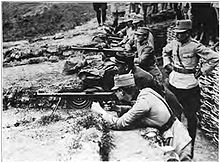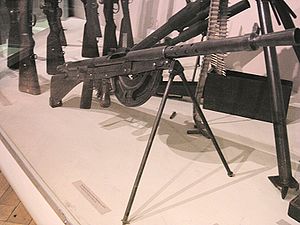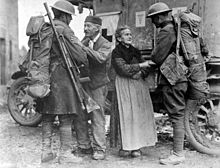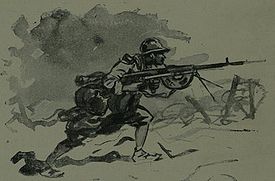- Chauchat
-
Chauchat
Chauchat LMG in the museum of the Polish Army in Warsaw.Type light machine gun Place of origin  France
FranceService history In service 1908-1945 Used by See Users Wars World War I
Polish-Soviet War
Winter War
Continuation WarProduction history Designer Louis Chauchat and Charles Sutter Designed 1907 Manufacturer Gladiator
SIDARMEProduced 1915 - 1922 Number built ~262,000 Variants Mle 1918 (.30-06)
Chauchat (Polish) (7.92x57mm Mauser
Chauchat (Belgium) 7.65x54mm MauserSpecifications Weight 9.07 kg (20.0 lb) Length 1,143 millimeters (45.0 in) Barrel length 470 millimeters (19 in) Cartridge 8x50mmR Lebel, others Action Long recoil with gas assist Rate of fire ~240 rounds/min Muzzle velocity 630 m/s Effective range 200 m Maximum range 2000 m Feed system 20-round magazine Sights Iron The Chauchat (pronounced "show-shah", named after its main contributor Colonel Louis Chauchat), was the standard light machine gun of the French Army during World War I. Under the leadership of General Joseph Joffre, it was commissioned into the French Army in 1916. It was also widely used by the US Army in 1917-1918 and by six other nations: Belgium, Greece, Poland, Russia, Serbia and Germany (who used captured examples) during and after World War I. Its formal designation in the French Army was Fusil mitrailleur Mle 1915 CSRG (Chauchat Sutter Ribeyrolles Gladiator). It was also more simply known as the FM Chauchat, CSRG and Gladiator.
Relatively small and lightweight, the Chauchat significantly increased the firepower of the infantry offensive. Over 262,000 were produced, making it the most widely-manufactured automatic weapon of World War I (1914–18). A variant chambered to the US .30-06 cartridge is known as the CSRG M1918. It was specifically designed for the American Expeditionary Forces (AEF), as a different weapon. However, the French 8mm Lebel caliber Chauchat was the model which was extensively used by the AEF. It was described in official AEF instruction manuals as the "Automatic Rifle Model 1915 (Chauchat)".
The Chauchat was one of the first light machine guns designed to be a mobile machine gun, carried and fired by a single operator and an assistant, without a heavy tripod or a team of gunners. It set a precedent for several subsequent 20th century firearm projects, being a portable automatic weapon built inexpensively and in very large numbers. The Chauchat combined a pistol grip, an in-line stock, a large-capacity detachable magazine, and selective-fire capability in a compact package of manageable weight (20 pounds) for a single soldier. It could be fired from the hip and also while on the move.
In the muddy trenches of northern France, several operational problems came to light, caused by the economical construction which had been simplified to allow emergency mass production. These problems allowed for the ingress of dirt and were the cause of 2/3 of all stoppages. After the World War I, the French replaced the Chauchat as the standard light machine gun with the Mle 1924 and later with the Mle 1924/29 light machine gun. The AEF in France eventually replaced it with the Browning Automatic Rifle, which appeared on the front lines of northern France in September 1918, barely two months before the Armistice of November 11.
Over time the Chauchat's poor reputation in the trenches because of the mud, dirt, and humidity to which the weapon was unadapted have led some modern experts to describe it as the "worst machine gun" ever fielded in the history of warfare . Furthermore, the gun's overall reputation was also damaged by the less than acceptable performance of the Mle1918 Chauchat, in US 30-06 caliber, a different model which had been specifically designed and manufactured for the American Expeditionary Forces (AEF) in France during World War 1. .[1][2][3]
Contents
History
The design of the Chauchat dates back to 1903 and its long recoil operation is based on the designs of the Remington Model 8 semi-automatic rifle of 1906, not (as so often repeated in the past) on the later designs (1910) of Rudolf Frommer, the Hungarian inventor of the commercial Frommer Stop pistol ( see:Demaison and Buffetaut,1995). The Chauchat machine-rifle project was initiated between 1903 and 1910 in a French Army weapon research facility located near Paris : the "Atelier de Construction de Puteaux" (APX). This development was aiming at creating a very light, portable automatic weapon served by one man only, yet functioning with the 8mm Lebel service ammunition. The project was led from the beginning by Colonel Louis Chauchat, a graduate from Ecole Polytechnique, assisted by the weapon designer Charles Sutter. Not less than eight trial prototypes were tested at the "Atelier de Construction de Puteaux" (APX), between 1903 and 1909. As a result, a small series of 8mm Lebel "CS" (Chauchat-Sutter) machine rifles was provisionally accepted and then manufactured at Saint Etienne, from 1910 to 1914, for the purpose of arming the observation crews of French military aircrafts.
In 1914, when World War I broke out, French troops did not operate any light machine-gun. It was clear that this type of weapon had become indispensable in modern warfare, because of the increase in firepower it could provide to an infantry section. Spurred by General Joffre, it was decided to adopt the Chauchat, above all else because the pre-war "CS" (Chauchat-Sutter) machine rifle was already in existence, thoroughly tested and specifically designed to fire the 8mm Lebel service ammunition. Furthermore, due to its projected low manufacturing costs and relative simplicity, the newly adopted (1915) "CSRG" machine rifle could be mass produced by a converted peacetime industrial plant. The term "CSRG" is made up of the initials of : Chauchat, Sutter, Ribeyrolles and Gladiator, four terms which are self-explanatory. Paul Ribeyrolles was the general manager of "Gladiator" , a peacetime manufacturer of motor cars, motorcycles and bicycles located in Pre-Saint-Gervais (a northern suburb of Paris). The fairly large "Gladiator" factory was thus converted into an arms manufacture in 1915 and became the principal industrial producer of Chauchat machine rifles during WW-1. Later on, in 1918, a company named SIDARME located away from Paris ,also participated in the mass manufacture of CSRG's.
Design details
The Chauchat light machine gun, or machine rifle, functioned on the long barrel recoil principle with a gas assist. The chronology of the patents makes it clear that Louis Chauchat had simply borrowed the mechanical principles of an already existing long barrel recoil, semi-automatic rifle filed by John Browning in his milestone U.S. Patent 659,786 of October 16, 1900. This precursor was the Remington Model 8 semi-automatic rifle which was successfully marketed (80,000) between 1906 and 1936.
Browning's long barrel recoil principle was also applied in 1907 to autoloading shotguns: the classic "Browning Auto-5" and the "Remington Model 11". Following behind these commercial developments, Lt. Colonel Louis Chauchat and armorer Charles Sutter, at Atelier de Construction de Puteaux (APX) arsenal since 1903, proposed a portable light machine gun based on the working principles applied in Browning's Remington Model 8 rifle. In 1908 it was dubbed Fusil-Mitrailleur C.S. ("C.S. Machine Rifle") and it used the 8 mm Lebel service cartridge. An improved version of the "CS" was also tested in 1913 with promising results. After the war had started in August 1914, the realization sunk in that automatic weapons had become essential for success on the battlefields. General Joffre, the Commander in Chief, pressed to adopt a portable automatic weapon for the infantry. The only thoroughly tested light machine gun which also fired the 8 mm Lebel cartridge was the "CS" machine rifle. It was quickly modified into the Fusil Mitrailleur Mle 1915 CSRG and adopted in July 1915. The "R" in CSRG stands for Ribeyrolles, manager of the Gladiator ("G") cycle factory, in the Paris suburb of Pre-Saint-Gervais. Manufacturing of the CSRG begun there in early 1916 and ended in December 1918. Another facility away from Paris (SIDARME) also manufactured CSRG's beginning in 1917. The Chauchat machine rifle (CSRG) delivered to the French Army fired the 8 mm Lebel cartridge at the slow rate of 250 rpm. At 9 kilograms (19.8 pounds), the gun was much lighter than the contemporary portable light machine guns of the period, such as the Hotchkiss M1909 Benet-Mercie machine gun (12 kg/26 lb) and the Lewis Gun (13 kg/29 pounds). It was a select fire weapon, either automatic or semi-automatic mode. The gun's ergonomics, rather than its recoil, were difficult to cope with but could be tamed by well-trained gunners.
The Chauchat's construction was composite thus not fully consistent in terms of parts quality. The recoiling barrel sleeve as well as all the bolt moving parts were precision milled from solid steel and always fully interchangeable. The barrels were standard Lebel barrels that had been shortened from the muzzle end. The barrel radiators were made of ribbed cast aluminum. On the other hand, the outer breech housing was a simple tube, betraying Gladiator's pre-war activities in motorcycle manufacturing. The rest of the gun was built of stamped metal plates of mediocre quality. Side plate assemblies were held by screws that could become loose after prolonged firing. The sights were often misaligned on the Gladiator-made guns, creating aiming problems that had to be corrected by the gunners. The exact number on record of Chauchat machine gun manufactured between 1916 and the end of 1918 is 262,300. The Gladiator factory manufactured 225,700 CSRGs in 8 mm Lebel plus 18,000 in the US caliber .30-06 between April 1916 and November 1918. SIDARME manufactured 18,600 CSRGs, exclusively in 8 mm Lebel, between October 1917 and November 1918. The SIDARME manufactured Chauchats were generally better finished and better functioning than those made by Gladiator. The French Army had a stock of 63,000 CSRG's just before the Armistice.
The French military at the time considered the Chauchat's performance as inferior in comparison to the reliable heavy Hotchkiss M1914 machine gun. However, whereas the Hotchkiss was a weighty, tripod-mounted weapon, the Chauchat was a light gun that could be mass-produced quickly, cheaply and in very large numbers. It was also never intended to take the role of static defense of the heavy machine gun but to be a portable weapon that would increase the firepower of infantry squads moving forward during the assault. A significant plus is that it could easily be fired while walking, by hanging the Chauchat's sling over a shoulder hook located onto the gunner's upper left side of his Y strap. The other light squad automatic weapons available at the time included the Hotchkiss M1909 Benet-Mercie machine gun, the Madsen machine gun or the Lewis Gun, but of these only the Hotchkiss M1909 could be successfully converted to accept 8 mm Lebel ammunition.
Battlefield performance
The Mle 1915 Chauchat's performance on the battlefields drew mixed reviews from the users when the war was stagnating in the mud of the trenches in 1916. This brought about a survey, regiment by regiment, requested by General Pétain in late 1916 - the survey's essential conclusion was that the open sided magazines were defective and caused about two thirds of all stoppages. Loose earth, grit and other particles easily entered the gun through these open-sided magazines, an ever present risk in the muddy environment of the trenches. Its long recoil action is often cited as a source of problems for the shooter. However recent firing tests have demonstrated that it is the Chauchat's ergonomics and its loose bipod, rather than its recoil, that makes it a difficult gun to keep on target beyond very short bursts. On some of the Gladiator-made guns, the sights also made the Chauchat shoot systematically too low and to the right. Overheating after long continuous firings (about 400 rounds) dilated the recoiling barrel sleeve to the point where it refused to return forward until the gun had cooled off, thus creating a stoppage that could last 10 minutes. Hence, the manuals recommended firing only in short bursts or semi-auto and insisted that only good magazines should be used.
Several prototypes of dirt-proof, fully enclosed Chauchat magazines were successfully tested in May and June 1918, but came too late. Stronger but still open-sided standard magazines as well as tailored canvas gun covers protecting the gun against mud during transport had previously been issued to all Chauchat gunners in 1917. The initial two-man Chauchat team was also found insufficient and eventually grew to a four-man squad by October 1917 (the squad leader, the gunner, the assistant gunner who handled the magazines plus one additional magazine carrier).
Later on, during the German spring offensive of 1918, the war had moved out of the mud of the trenches and into open fields, thus making the guns more reliable and easier to maintain. Furthermore, French infantry regiments had been reorganized into multiple small (18 men) combat groups ("Demi-Sections de Combat"). Those were made up of a full Chauchat squad plus four VB (Viven-Bessiere) rifle grenade specialists and eight conventional grenadiers/riflemen. At this point in time, in 1918, the preserved French regimental records and statistics of medals given to Chauchat gunners document that they had contributed in no small part to the success of the new infantry tactics. Those were focused on the suppression of enemy machine gun nests by the combined action of portable (Chauchat) automatic fire plus the VB rifle grenades, always used within a range of less than 200 yards.
Comparison
The Chauchat was not comparable to the submachine guns of World War I, which used pistol rather than rifle ammunition and were thus less powerful. The Italian Villar-Perosa and Beretta Model 1918, the first two submachine guns to appear in World War I, fired the 9 mm Glisenti (a less powerful version of the 9mm Parabellum). The MP18 Bergmann, a German Army submachine gun fielded during the spring of 1918, fired the 9 mm Luger cartridge. Compared to the Chauchat, these early submachine guns were used in relatively small numbers (thousands rather than hundreds of thousands), and had much shorter effective ranges.
Unlike much heavier air-cooled and water-cooled machine guns (such as the Hotchkiss machine gun and the various belt-fed Maxim gun derivatives), and in common with the Lewis Gun, the Chauchat was not designed for sustained defensive fire. The tactical edge expected from the Chauchat was to increase the infantry's offensive firepower during the assault.
American Chauchats
After the USA had entered World War I, in April 1917, the American Expeditionary Force (AEF) arrived in France without automatic weapons or field artillery. It turned to the French ally rather than to the British to purchase ordnance. General Pershing chose the Hotchkiss M1914 medium machine gun and the Chauchat light machine gun (dubbed "automatic rifle" by the AEF and nicknamed the "Sho-Sho" by the troops) to equip the U.S. infantry and if handled properly served the soldiers well. Between August 1917 and the November 11, 1918 Armistice, Gladiator delivered to the AEF 16,000 Chauchat "automatic rifles" in 8 mm Lebel and, late in 1918, 18,000 Chauchats in .30-06.
While the performance of the M1915 Chauchat in 8MM Lebel was considered acceptable at the time, the performance of the M1918 Chauchat in .30-06 was soon recognized as abysmal (and in large part the reason for the gun's bad reputation) : the common problem was a failure to extract after the gun had fired only a few rounds and became slightly hot. Based on archival records and recent trials, including a firing test performed at Aberdeen Proving Grounds in July 1973, the adaptation of the Chauchat to use .30-06 ammunition had been compromised by incorrect chamber measurements and sub-standard manufacturing. The preserved archival records show that US inspectors at the Gladiator factory rejected about 40% of the 30-06 Chauchat production while the remaining 60% proved problematic whenever some small allocations reached the front lines. Supplies of the newly manufactured and superior Browning Automatic Rifle (BAR) were allocated sparingly and only very late, during the Meuse-Argonne offensive which begun in late September 1918. Therefore about 75% of the U.S. Divisions were still equipped with the Chauchat - in its original French M1915 version in 8mm Lebel- at the Armistice of November 11, 1918. It is also well documented that General Pershing had been holding back on the BAR until victory was certain, for fear it would be copied by Germany (Ayres, 1919). (Other accounts, however, state that the reason that the BAR didn't see much combat was because the first units equipped with them simply didn't arrive until September.)[citation needed] However, it is also known that the very first BAR's delivered had improperly tempered recoil springs and had these guns been prematurely introduced during the summer of 1918, they might have also been viewed as problematic.
As to the U.S. Marines, they had initially received .30-06 chambered Lewis Guns, but had to exchange them for Chauchats after their arrival in France (This was the result of an old feud between Mr. Lewis and the superior officer in charge of the U.S. Ordnance Department).[citation needed]
As a matter of interest and as documented by World War I veteran Laurence Stallings (in "The Doughboys", 1963) and by U.S. Divisional Histories, Medal of Honor was awarded to three American Chauchat gunners in 1918: 1) Private Nels Wold (35th Division, 138th Infantry). 2) Private Frank Bart (2nd Division, 9th Infantry) and 3) Private Thomas C. Neibaur (42nd Division, 107th Infantry).[4]
Users
 Belgium: 6,935
Belgium: 6,935 Finland: 5,000
Finland: 5,000 France: over 120,000 placed in actual front line service at the squad level between April 1916 and November 1918.
France: over 120,000 placed in actual front line service at the squad level between April 1916 and November 1918. Greece: 3,980
Greece: 3,980 Italy: 1,729
Italy: 1,729 Kingdom of Romania: 7,200
Kingdom of Romania: 7,200 Russia: 5,700
Russia: 5,700 Serbia: 3,838
Serbia: 3,838 Poland Blue Army: 11,869
Poland Blue Army: 11,869 United States (1917–1918): 16,000 in 8mm Lebel plus 18,000 in U.S. 30-06, the latter model being unsatisfactory.
United States (1917–1918): 16,000 in 8mm Lebel plus 18,000 in U.S. 30-06, the latter model being unsatisfactory.
 Crown Prince Carol of Romania firing a Chauchat
Crown Prince Carol of Romania firing a Chauchat
A number of captured Chauchats were used by German frontline infantrymen in flamethrower units because they had no light machine guns of their own until the portable Maxim MG 08-15 light machine guns were issued to them during early 1917. [1] Most of the Belgian Chauchats were converted to fire their 7.65 mm Mauser ammunition. Poland received French military assistance after World War I and received over 2,000 Chauchats as part of a weapon transfer and used them during the Polish-Soviet war. After the war Poland bought more of them and their number reached 11,869, becoming a standard Polish light machine gun in the 1920s. According to some publications, a small number were modified in the 1920s to use German 7.92mm Mauser ammunition, but there is no clear confirmation. In 1936-1937, 8,650 were sold abroad, probably to Republican Spain.[5] During the Winter War between Soviet Union and Finland, over 5,000 Chauchats were donated to Finland which lacked automatic weapons. Some remnants of the Chauchat design are reported to have appeared in the 1960s during the Vietnam War.
Replacing the Chauchat: the "Fusil-Mitrailleur (FM) Mle 1924-29"
The French military decided during the post-war years to urgently upgrade with a more reliable light squad automatic weapon. The new light portable machine gun was developed at the "Manufacture d'Armes de Châtellerault" during the early 1920s, culminating in the adoption of the F.M.Mle 1924. The new light machine gun (in French :fusil-mitrailleur) had been designed by Lt. Colonel Reibel and Controller Chosse and was gas operated, like the Browning Automatic Rifle (BAR) which had inspired the new gun's internal features. The venerable 8 mm Lebel round, which was one of the major handicaps of the Chauchat, had been discarded for a 7.5 mm rimless cartridge resembling a necked down 7.92 mm German Mauser round. The F.M. Mle 1924 featured a bipod, an in-line stock, a pistol grip, a top-mounted 25 round magazine and a bolt hold-open after the magazine's last round had been fired. Protection of all the openings against mud and dust was excellent. The cyclic rate was 450 rounds per minute. It was modified in 1929 to accept a slightly shorter 7.5 mm cartridge that could not be mistaken for a German Mauser round or a Swiss 7.5 mm round. The new weapon and modern rimless ammunition had finally corrected all the problems associated with the Chauchat. The reliable and well-liked FM (Fusil-Mitrailleur) Mle 1924 was manufactured in large numbers (187,000) and widely used by the French Army until the late 1950s. The Gendarmerie Nationale used it until the late 90s when it was phased out after all 7.5mm ammunition stocks were depleted.
See also
- Chauchat-Ribeyrolles 1918 submachine gun
- Hotchkiss M1909 light machine gun
- List of individual weapons of the U.S. Armed Forces
- List of infantry weapons of World War I
References
- ^ Fitzsimons, Bernard (1978). The Illustrated Encyclopedia of 20th Century Weapons and Warfare. 6. Columbia House. p. 584. ISBN B001CSIHPO.
- ^ Hogg, Ian (2000). Military Small Arms of the 20th Century (7 (illus.) ed.). Krause. p. 317. ISBN 9780873418249.
- ^ Jordan, David (2005). History of the French Foreign Legion: 1831 to the Present Day. Spellmount. p. 167. ISBN 9781862272958.
- ^ Medal of Honor Recipients World War I army.mil
- ^ Andrzej Konstankiewicz, Broń strzelecka i sprzęt artyleryjski formacji polskich i Wojska Polskiego w latach 1914-1939, Lublin 2003, ISBN 83-227-1944-2
- Demaison, G. and Buffetaut, Y. (1995). The Chauchat Machine Rifle. Collector Grade Publications Inc.. ISBN 0-88935-190-2.. The most complete (209 pages), best documented and profusely illustrated (246 illustrations) source on the subject.
- Handbook of the Chauchat Machine Rifle, Model of 1915. U.S. Government Printing Office, Washington, D.C.. 1917.
- Bruce, Robert (1997). Machine Guns of World War 1: Live firing classic military weapons. Windrow and Greene. ISBN 1-85915-078-0.
- Canfield, Bruce N. (2000). U.S. Infantry Weapons of the First World War. Andrew Mowbray Publishers. ISBN 0-917218-90-6.
- Stallings, Laurence (1963). The Doughboys - Story of the AEF, 1917-1918. Harper and Row, New-York.
- Major General William Crozier (1920). Ordnance and the World War. Charles Sribner and Sons, New York.
- Leonard P Ayres (1919),The War with Germany-A Statistical Summary, US Government Printing Office, Washington, D.C..
- ' Provisional Instruction on the Automatic Rifle, Model 1915 ( Chauchat ) " ,Translated from the French Edition of February,1916 and Revised to June 9, 1917, at Headquarters American Expeditionary Forces, France, War Document #732. Reprinted by University of Michigan Library ( June 2010 ). ISBN 3 9015 02705 8158.
External links
US infantry weapons of World War ISide arms Rifles Automatic rifles Chauchat · M1918 BARGrenades Shotguns Machine guns and larger Cartridges Categories:- World War I infantry weapons of the United States
- World War I French infantry weapons
- Light machine guns
- Machine guns of France
- World War I machine guns
Wikimedia Foundation. 2010.



